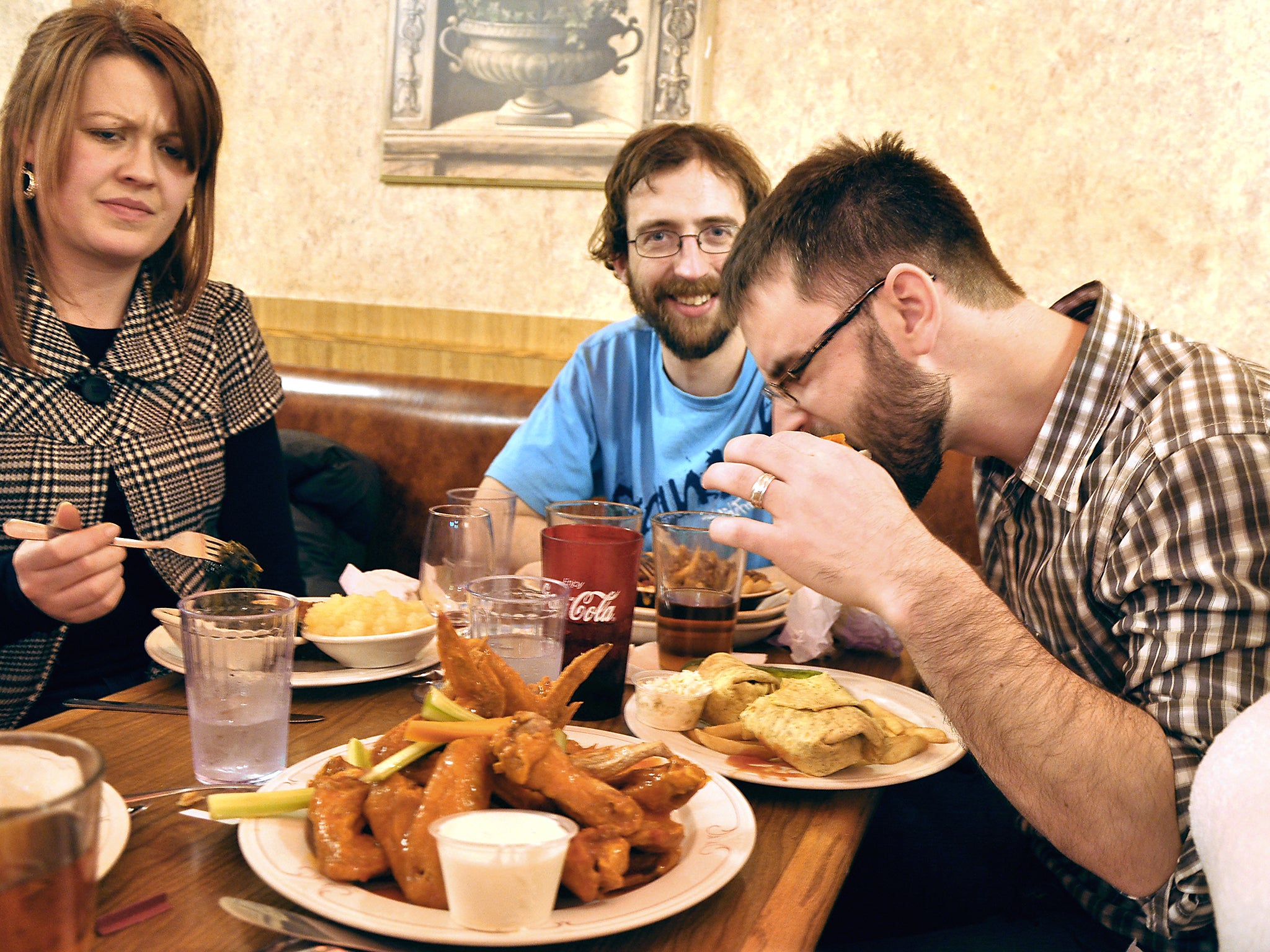Here’s to etiquette and not chewing with your mouth open
How did table manners evolve into a way of defining power relations between individuals and societies? The author of ‘The Rituals of Dinner’ has a few ideas

Your support helps us to tell the story
From reproductive rights to climate change to Big Tech, The Independent is on the ground when the story is developing. Whether it's investigating the financials of Elon Musk's pro-Trump PAC or producing our latest documentary, 'The A Word', which shines a light on the American women fighting for reproductive rights, we know how important it is to parse out the facts from the messaging.
At such a critical moment in US history, we need reporters on the ground. Your donation allows us to keep sending journalists to speak to both sides of the story.
The Independent is trusted by Americans across the entire political spectrum. And unlike many other quality news outlets, we choose not to lock Americans out of our reporting and analysis with paywalls. We believe quality journalism should be available to everyone, paid for by those who can afford it.
Your support makes all the difference.Most people are disgusted by diners eating with their mouths open. Chewing is widely expected to be performed with the lips absolutely shut. Then there is the etiquette of talking at dinner parties – in polite company everybody should be prepared to talk during dinner. In such settings it is rude to eat and not talk, unless the meal is a very intimate one where the rule is ignored or dropped.
We need never think of our manners as weakening as long as this fiendishly difficult skill is demanded of us, that when we are in a convivial group we shall talk at all the correct moments, saying everything we should, and even everything we mean, but never be caught doing so with our mouths full. Talking is of course one of the ways in which we “rise above food”: we are not at table merely to eat, but in order to enjoy each other’s company. “It isn’t so much what’s on the table that matters,” said WS Gilbert, lyricist partner of Arthur Sullivan, “as what’s on the chairs.”
The ancient Greeks never tired of reiterating that “stomach” was not enough, one needed “mind” (psyche) as well; that civilised people came together for each other and for philosophy, and not just to stuff themselves. A philosopher-host like Menedemus would provide a meal for only one or two of his guests. The others would have to dine before coming, bring their own cushions, and be content with a sip for everybody from one half-pint cup and nothing but a lupine or a bean for dessert. He offered a token dinner but made it impossible for most guests to come to the party for anything but the conversation.

Like most people, the Greeks and Romans seldom described their table manners in detail because they considered them common knowledge. Greeks in fact talked little during the meal itself. A few things were said, one of the tasks apparently being to decide while dinner was being eaten what the subject of conversation would be when talking did get under way. The symposium or drinking party was the place and time for discussion, whether serious or trivial. Subjects at symposia ranged from “What is love?” to “Why meat spoils more readily in moonlight than in sunlight.”
In Homeric times it was considered rude to expect a stranger to speak at length to his hosts before he had eaten his fill; he was not even asked his name until he had been given dinner. But when speaking began, it was polite to contribute what one had to offer. People knew you by the way you behaved: it was only fair to give them material with which to make their judgement of your worth.
In some societies drinking and talk is done before dinner. A large Sherpa party begins with two, three, four, even five hours of discussion, quarrelling and joking, all oiled by the drinking of beer. A large crowd assures people that they can work through grudges in safety, while at the same time assessing the opinion of neighbours and finding out who their friends are. Eventually silence falls, and everybody gratefully and happily eats. In the silence, any rough edges left by communal friction are smoothed over by the action of eating together. In China and Iran, the traditional rule is also “talk first, then eat.”
Some, among them the Newars people of Kathmandu, feel that silence when eating is formal behaviour to be maintained in public; among friends and family one may talk, laugh, and dine at the same time. Other societies, including many people in our own culture, feel exactly the opposite on this point. The Japanese banquet begins in silence, that is, with formality and caution, and then “warms up,” becoming louder and friendlier as it goes on. The “lubricating” effect of alcoholic drinks can help this transition to occur.
Often a compromise is sought between silence and speech: entertainment is laid on during the actual eating. (We have seen that elaborate theatrical interludes once took place in the entremets of a medieval banquet, that is, not during the serious eating but between courses.) People often like watching what they are doing when they eat. So the entertainment, unless most eating stops while it is going on, tends to be auditory; the guests keep silent and eat, while someone reads or speaks.
There might be singing, as in the Saxon hall or at Homeric feasts. At ancient Greek symposia, guests would take turns singing; a myrtle branch was passed to each singer so that it was clear whose turn it was, and to make sure there were no rowdy interruptions. Non-dining instrumentalists who play for the company have an ancient history; the tradition continues in some restaurants today. Where there is musical accompaniment, there have to be rules enjoining silence so that others can hear the music.
It is increasingly remarked that North Americans watch more and more television during everyday meals at home. As many as 78 per cent are thought to watch at least once or twice a week during dinner; about 24 per cent of these always have the television on. The average length of an American dinner, with or without TV, is 30 minutes, which suggests that not a great deal of discussion is taking place. For many a “proper” Sunday dinner in Britain necessarily means no TV.
When people sorrowfully note the passing of dinner-time conversation, at least at family meals, we might recall that eating in silence is by far the most common human choice, and that entertainment has often replaced talk – unless food is turned into an art form, or the family gathering into an occasion for education or celebration. We have made silence informal partly because for us formal occasions require verbal communication. But where families spend less and less time together, removing dinner-time talk may well be a serious deprivation: it takes away what was scarce in the first place.
Western European culture has worked hard on polishing the art of conversation. Erving Goffman has pointed out that the family-sized dining-room table is a specially created “open region,” where participants have the right “to engage anyone present”.
Talking at the table is important for the information which is provided for others about any speaker who is not well-known to them. The purpose of dinner-table conversation is partly to force people to go through their paces: to show that they have learned the rules and “polished” themselves and will therefore, in the estimation of the company, “do”.

Manners can constitute a cruel enforcement of class barriers. At the table there is nowhere to hide, and the rule against silence means no refuge from having to perform. “Taciturn people,” states one 19-century etiquette book firmly, “are not good for society, and should avoid it”.
The art of dinner-table conversation, as it evolved from the 17th century, was that of interaction almost for its own sake. Diners displayed their social awareness, their manners and tact, and showed respect for the rules they were all keeping. The young, for instance, had to defer to the old, keep silent most of the time, and yet demonstrate that they were listening and interested. They had not to put anything in their mouths while being spoken to, or hold on to a glass as though waiting for the interlocutor to stop talking in order to have a drink. They must never imitate – inadvertently of course, one would never do it on purpose – the expression on the face of anyone addressing them.
Manners were in part a moral code, forcing “good breeding” to include consideration for other people’s rights and feelings. No one should show preferential treatment to any one guest over all the others, no two people should whisper together, and explanations were required if anyone laughed during a conversation that was not general, just in case someone thought they were being laughed at. No one must offend a guest by pronouncing a witticism at his or her expense. A host, in spite of or because of his power, ruined his reputation if he spoke too much, praised himself, served himself first, praised the dishes, or spoke about meals he had given before or dishes he had eaten and liked.
It was good manners, and openly acknowledged as such, not to draw attention to oneself, not to be loud, embarrassing, repetitious or boring – perhaps it’s no coincidence first recorded use of the word “bore” is from 1766. One was expected, by our standards, to be deliberately artificial, thinking of subjects for conversation in advance, preparing witticisms, polishing paradoxes, seeking occasions to insert them – but all must be done with an air of complete naturalness and simplicity, with what the French were calling je ne sais quoi. Any signs of trying too hard, of not taking all the circumstances into account, not only spoiled the story being told but much more permanently ruined the reputation of the speaker. Displaying a sense of ease was proof of being practised in social graces, of “good breeding” and “a fine upbringing”.

By the late 19th century, the rules – those expressed in the manners books, at any rate – were even more careful. People were supposed to memorise the names of everyone to whom they had an introduction (powerful and popular persons severely limited the number of people who could be introduced to them), and to talk correctly and without slang or vulgarisms such as “awfully pretty” and “immensely jolly”. One listened even to the most boring talker: this was a person who had been deem – though an extremely experienced dinner-goer could save her hatred, her hostess’s feelings, and the smooth operation of the whole gathering, all at the same time. Emily Post describes how “At dinner once, Mrs Toplofty, finding herself next to a man she quite openly despised, said to him with apparent placidity, ‘I shall not talk to you – because I don’t care to. But for the sake of my hostess I shall say my multiplication tables. Twice one are two, twice two are four–’ and she continued on through the tables, making him alternate them with her. As soon as she politely could, she turned again to her preferred interlocutor.”
Victorian books on manners, reflecting as they do the ideal of gentlemanly and lady-like behaviour, exhorted polite people to be sympathetic and animated but never flippant. Compliments must be sincere but flattery is vulgar, and scandal and gossip a disgrace. One must never interrupt, or allude to another person who is at the table (“How awkward to ask, ‘Who is that vulgar, red-faced woman?’ and receive the reply, ‘My wife, Sir’”). Private or indelicate matters must not be mentioned, or even given an opportunity to be thought of. Foreign languages, and even quotations from the classics, should be avoided, together with all ostentatious displays of knowledge, expatiation on one’s hobbies, and dogmatic opinions: “Politeness is universal toleration.”
No wonder it was so important to carry about a stock of small talk, and that successful hosts tried everything they could think of to keep the conversation flowing upon ego-soothing and probably safe subjects: “In order to prolong the time, and to enjoy the gentlemen’s society as much as possible,” wrote Alexis Soyer in 1853, “I do not have the dessert placed on the table until 10 or 20 minutes after the cloth is removed; this gives an opportunity for my guests to admire the beautiful Sèvres dessert plates, containing views of different French châteaux; this, of course, gives a subject of conversation to those who have visited them.”
Dessert has remained a favourite focus for conversation, especially in those cultures where the table is still “de-served” or desservie, meaning that everything is removed and the cloth swept clean so that talking can continue, only raised to a higher intensity. In Hispanic countries the practice of conversation after dinner – the descendant of Greek and Roman symposia but without the copious drinking – is called hacer la sobremesa, “doing the tablecloth” or “doing dessert”. Coffee is brought to the table (the sweet course itself usually counts as part of the dinner, and is removed for this ritual) and the guests linger, talking, sometimes for hours together. The Danes are similarly famous for conversation round the table. The table is felt to aid the conversation: moving away to the “withdrawing” room would mean a break in the togetherness achieved during dinner, and a moving apart from one another. The comfort of padded armchairs is not enough to tempt the group away. The table is something to lean on, to gesture over; it expresses what everyone has in common.
Margaret Visser’s ‘The Rituals of Dinner’ published by Penguin in trade paperback, priced £9.99
Join our commenting forum
Join thought-provoking conversations, follow other Independent readers and see their replies
Comments